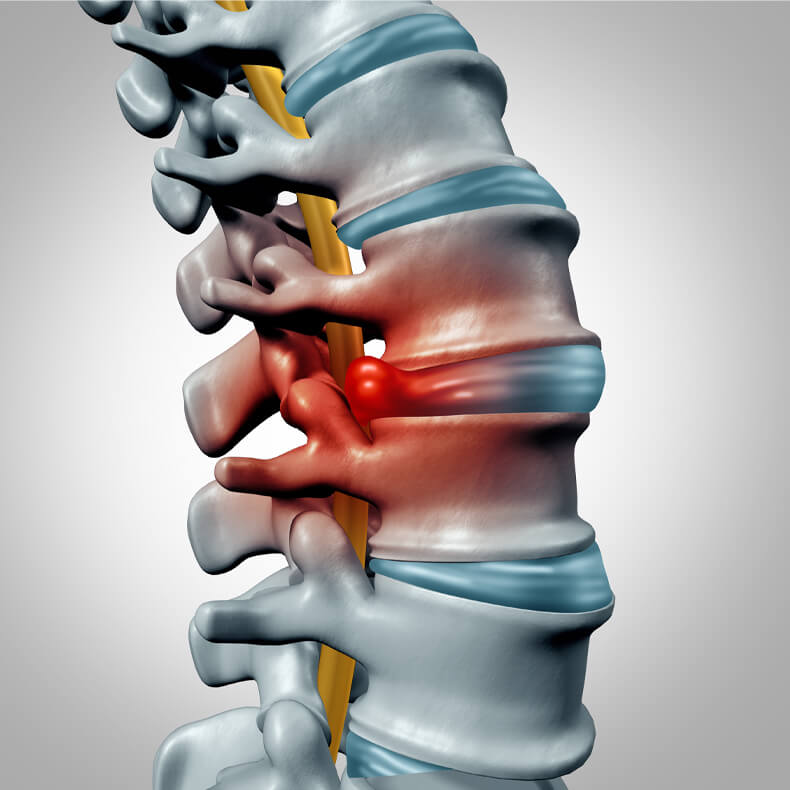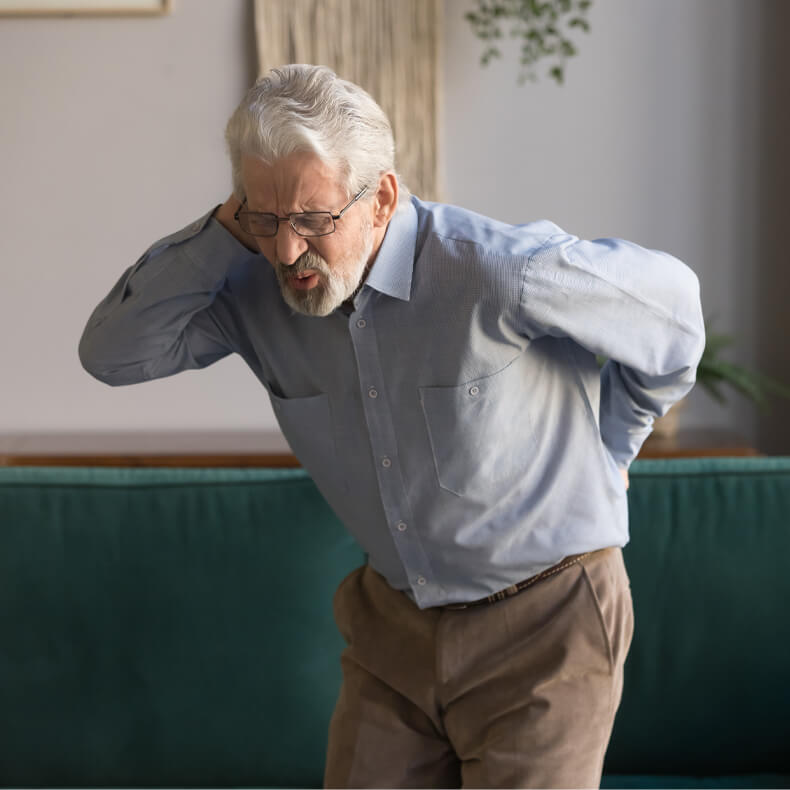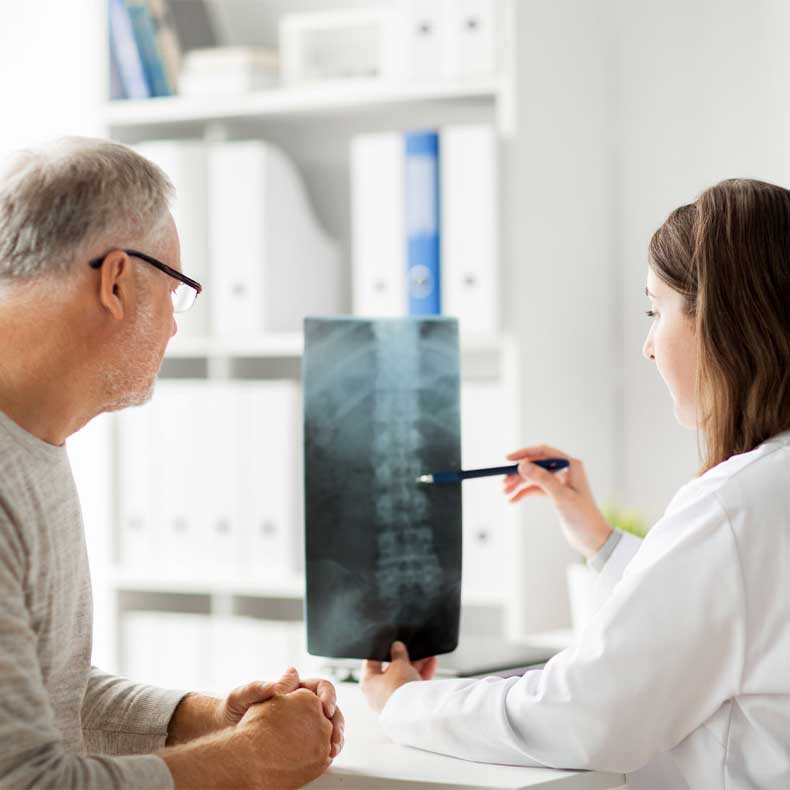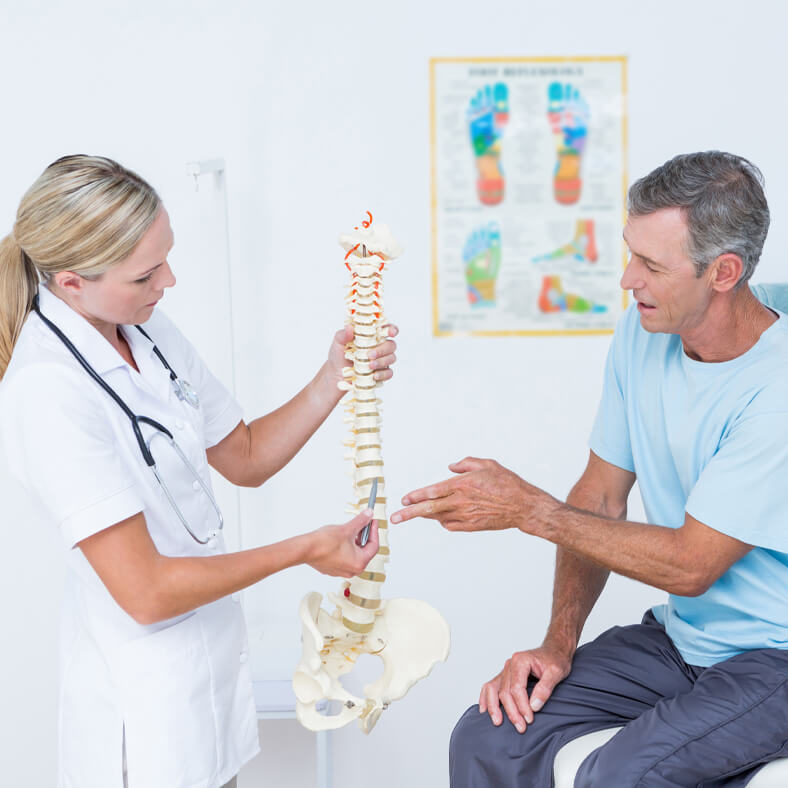Stop Herniated Disc Pain!
HERNIATED DISC IN NECK TREATMENT OPTIONS
- Stop pain in the neck
- Pain down your arms
- Pain through out your back
WE BELIEVE IN PRESERVING MOTION WHENEVER POSSIBLE!
So What Is A Herniated Disc?
If you are experiencing pain in your neck, back or arms then you might be suffering from herniated disc in the neck. We believe in and specialize in cervical arthroplasty (also known as cervical disc replacement). We believe in preserving motion whenever possible. Doctors oftentimes refer to this as a "cervical herniated disc" or sometimes a "slipped disc".
Although the disc doesn't really "slip", it can tear open, causing the fluid inside to push against the surrounding nerves (referred to as a ruptured disc) causing extreme pain or nerve damage to your spinal cord, neck or even your arms.
Symptoms of a cervical herniated disc may include pain that radiates from your neck down your spinal canal or into your arms. This is referred to as "spinal cord compression". Some common spinal cord compression symptoms are, difficulty moving your neck or shoulders or shocking tingeing feelings going down your back into your legs. This can cause weakness, numbness or tingling in your shoulder, arms and even your hands. Certain positions or movements of your neck can also trigger extreme pain in your spinal nerves due to a herniated disc.

WHAT ARE SOME SIGNS OF A HERNIATED DISC?
Herniated comes from the word "hernia" which is a part of the body that bulges out through an abnormal opening.
Disc is the disk-shaped cushion known as the "intervertebral disc" that sits between the bones. This disc material gives your bones that soft gel like center cushion allowing you to easily flex and bend.
A Herniated Disc is the result of a rupture in the fibrous outer portion of a spinal disc. This forces the core to squeeze out, creating a disc herniation. Think of it like a jelly doughnut that gets squeezed causing the jelly to ooze out.
Herniated discs are most often caused by excessive stress being placed on the disc in your neck or back. Whether it is caused from heavy lifting, or other damaging motions, it can all happen at a moments notice when you least expect it.
Sometimes, pain and other symptoms can develop when a damaged disc pushes into the spinal canal or nerve root without you doing anything major to cause it.
What Are The 2 Biggest Problems?
PROBLEM #1 Most patients who are experiencing a disc herniation in their neck have found it difficult to lay down and sleep. This is due to them experiencing sharp back pain or neck pain when they lay down or roll over. Because of this, it sometimes less painful for them to sleep sitting up than trying to lay down in their natural sleeping position.
PROBLEM #2 Some patients have also experienced arm pain, numbness or muscle weakness in their arms making it difficult to pick things up or control their hands. They may also notice strong sudden feelings of tingling in their neck, back, or arms. Or perhaps a more painful feeling like being stuck with pins and needles all of a sudden.
It is these types of feelings that are caused by cervical herniated discs which can trigger nerve compression triggering pain all the way down to your nerve roots within your cervical spine. A herniated disc occurs when the gel like material ruptures within your discs through a tear in the disc wall. This gel like material causes irritation to your spinal nerves creating a chemical-like irritation.

WHAT DOES A CERVICAL HERNIATED DISC IN THE NECK FEEL LIKE?
by Dr. Benjamin Geddes
HOW TO HELP RELIEVE PAIN OF A CERVICAL HERNIATED DISC
In most cases, nonsurgical treatment alternatives to spine surgery may be used to help you relieve pain that comes from a herniated disc. One of the most common nonsurgical treatments is physical therapy.
In many cases, physical therapy can help reduce swelling between your discs and help reduce inflammation in your neck and arms without having to forgo spine surgery.
After forging therapy most people (even older people) can tell in a few days if it helped or not. The joints in your neck, arms and back should feel like fresh shock absorbers that move easily and freely without any pain.
But What If The Symptoms Continue?
If after forging physical therapy you are still experiencing the same pain in your neck, shoulders, arms or back, then it is recommended that you see a cervical herniated disc doctor about a more aggressive treatment plan.
We recommend you call and make an appointment with Dr. Sielatychi or Dr. Geddes to discuss your cervical herniated disc symptoms with them. They will listen to your situation and provide you with the best cervical herniated disc medical attention possible.
In many cases, after talking with them you will know if you simply have temporary pain from lifting a heavy object or if you have a much more serious condition that needs medical attention and what the risk factors might be.

COMMON SYMPTOMS OF A CERVICAL HERNIATED DISC
The most common symptoms a cervical herniated disc causes are:
- Difficulty with fine motor skills using your hands and arms
- Numbness or weakness in your leg muscles
- Back muscle spasms
- Continuous back pains (which get worse by sneezing, prolonged standing, and coughing)
- Reduced knee and ankle reflexes
- Walking issues
- Reduced bladder function
- Sciatica: Pain that moves from your back or buttocks to the leg and calves, then into the foot.
- Loss of coordination
A herniated disc can cause any of these symptoms to occur causing additional wear and tear on your body leading to other conditions which can cause further complications.
If you are experiencing any of these symptoms, we recommend you consult with Dr. Sielatychi or Dr. Geddes to discuss your symptoms and what might be causing them. They will help you identify the problem and help you put a stop to cervical hibernated disc pain you are experiencing.
Message From Dr. J. Alex Sielatychi
QUESTIONS A CERVICAL HERNIATED DISC DOCTOR WILL ASK
The first step to pinpointing what is causing your neck, back, or arm pain is for Dr. Sielatychi or Dr. Geddes to do a physical exam with you. This will give them more information about your daily activities and help them discover how to reduce swelling you might be experiencing. They will
- Ask you where you feel pain at (neck, arms or spinal cord)
- Discuss if you have experienced a traumatic event in the past
- Find out if you have had any "Shock" type feelings in the past
- Examine your current health information
- Make sure your healthy weight is not part of the cause
- Perform an examine to find out if you have good posture or poor posture.
- Find out if you have had any past neck, shoulder or back problems or muscle weakness
- Discuss any nonsurgical treatments you have tried in the past
- Discuss all forms of pain relief you may have previously taken.
- Ask if you have been using any muscle relaxers or any forms of pain management.
- Perform an x ray or imaging studies to see if your disc material pushes on you anywhere
After Dr. Sielatychi or Dr. Geddes are done with your examine, they will be able to give you further advice as to if surgery may or may not be the best way to cure your cervical disc pain. If they feel that a cervical disc herniation surgery procedure would be appropriate, they will set up the best time for you to come in and for the procedure to be performed.
Message From Dr. J. Alex Sielatychi
OUR DOCTORS PROVIDE MEDICAL ADVICE ON CIRVICAL DISC HERNIATION
MOST COMMON QUESTIONS ABOUT CERVICAL DISC HERNIATION
- How serious is a herniated disc?
- What does a herniated disc feel like?
- Can a herniated disc heal on its own?
- What should you not do when you have a herniated disc in the neck?
- What is the fastest way to heal a herniated disc in the neck?
- Is herniated disc in the neck a permanent disability?
- Can a herniated disc in the neck heal without surgery?
- What is the best treatment for treating a herniated disc in the neck?
TOP MEDICAL ADVICE FROM OUR HERNIATED DISC DOCTORS
Dr. J. Alex Sielatychi
Dr. Benjamin Geddes
Dr. Scott Hodges
CERVICAL HERNIATED DISC TESTS AND DIAGNOSIS
On your first consultation with one of our qualified Doctors, they will want to check to see what level of pain you are experiencing and which of the symptoms above you are experiencing the most pain from.
When a doctor sees and understand some of your symptoms, he might recommend one of the following tests to find out where exactly the pain is originating from and what can be done to remove it:
- Magnetic resonance (MR) imaging: This is the best diagnostic method. It involves imaging the spine, nerve roots, ligaments, and more.
- Computerized tomography (CT) scan: Several X-rays that show 3D images of the body’s structures
- Myelography: Injecting liquid dye into the spinal column and using X-rays and computerized tomography (CT) scans. The procedure shows images that will identify indentations in the spinal fluid sac that come from a herniated disc.
- Electromyography (EMG): This tests a nerve root’s electrical activity and can show the root cause of pain.
